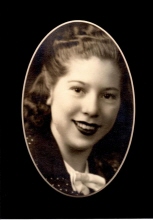Beatrice D. Lozano

May 15, 1924 ~ October 8, 2011
Bea, quite a bit younger than her siblings, began her tutorial career at Sam Houston Elementary School. She proceeded to Washington Irving Middle School, and then Technical Vocational High Shcool where she concentrated in retail sales, seeming common for women in the 1940's. Gender stereotyping was seen at an early age for my Grandmother, unlike my generation who had to have the majority of it pointed out to her in college. There was a strict social structure to her high school job placement. Her retail concentration, not urprisingly, consisted of all girls. It has been shown that high child birth, little educational background, and unstable employment curves the Hispanic female to clerical work, (Freeman, 1995 ). The only recollection of co-ed classes she found was in the Performing Arts, such as chorus and orchestra. Bea never graduated from high school due to her early marriage at seventeen to Faustino E. Lozano. This is common for Latin American women into the 1990's as well, with only a 42.4% graduation rate below the poverty level,(WAC Stats, 1993). In 1978 however, she managed to attain a GED in Texas while caring for her ill mother. She, after a one year stay at a junior college, San Antonio Community College (SACC), gained some higher level educational work, but it was never seen thru to graduation.
I asked my Grandmother what aspirations she had as a child or adolescent. I wanted to know how she would have molded her future without socioeconomic restraints. I was astonished by her answer. She claimed she had no grand plan or idea for the future. Apparently the socioeconomic level that she held as a youngster, she felt extremely confined to. It seemed a life of little advancement within the realms of higher education and financial status. So, an answer to my question, untainted by the bonds of social repression was not possible? One cannot assume to know or feel things that they themselves have not experienced. Hispanic women are two and a half times more likely than Caucasian women to be poor, (Lips, 1997). What aspirations can one have?
Bea concentrated more on social and athletic endeavors as an escape.She was a popular girl within her community and well known for her competitive edge. Social achievement in her community was much more easily attainable.
Every memory of my childhood involves my Grandma Lozano: from camping vacations, to Little League baseball games, to silly Saturday afternoons at the roller skating rink sucking on Jolly Ranchers. I have always felt as if I got my strength, independence, and confidence from the Lozano women. She was truly a pioneer. I can even recall my mother telling a story about coming home to California from Connecticut, after her divorce, and commenting on how my grandmother was ahead of her time. Apparently she was wearing slacks when she went to pick my mother and brother up from the airport. As insignificant as this may sound it was the 1960's. Women, especially Hispanic women, did not wear pants. They wore skits and house dresses that embodied purity and innocence. "Viva la machismo!" thank God for that woman!
Josie Bea Lozano, born Josephine Beatrice Davis, was reared in San Antonio, Texas. "Granny" Beatrice Briones brought her into this world on May 15th, 1924. Her story, like all children's begins with her Mother.
Beatrice Briones was reared by her Grandmother, due to the loss of her own mother in Mexico. Following the death of her grandmother, she was placed in a convent and brought up by the nuns residing there. It was at the age of twelve that a Mexican family moving to New Jersey contracted the help of the Great-Grandmother as a nanny. At fifteen she moved to San Antonio, Texas with them and stayed there after her commitment to them was fullfilled.
It was here, in San Antonio, Texas, that Granny Briones worked in a laundry. She had three children; Maria Luisa Alvarez, August Caesar Heuer, and Josephine Beatrice Davids. After an injury to her foot, she became a stay at home Mom. Someone had to make the nine dollars a month house payment however, so the two eldest children went to work. My Grandmother's nine year old brother went to work selling newspapers and shining showes while her fifteen year old sister danced in the theatre, both still attending school.
I was concerned with her answer, about her aspirations as a youngster. It denoted a lack of ambition to me; this was not my grandmother! I asked more plainly: if she could have been anything, at any point in her life, with nothing stopping her and nothing to lose, what would she have become? "A Nurse!" she replied without hesitation. My faith was restored in the idea that the "American Dream" was owned by everyone. It turns out she always wanted to be a nurse. In the early 1980"s, Bea was awarded a Nurses Aid certificate, NA, from the state of California after a six month stay at the bedside of her son Gilbert who was battling a coma after a severe car accident. Maybe a piece of her dream was achieved.
At sixteen years old Bea got a job at a radio repair shop putting knobs on, testing repairs, and concentrating on customer relations. She just wanted to buy herself clothes for school, for hers were out of date hand-me-downs. I was a girl that always had the newest styles and best brands. I was shamed and heartbroken at my Grandmothers statement.
Before getting married, Bea worked in the notions section of a department store earning $.25, a baby clothes factory, and a drugstore as a cashier. After marriage she became a military wife, following her husband.n 1952 she got a job at Kelly Field Air Force Base in electronics making $.99 an hour. At the same time she helped her husband distribute newspapers for extra money.Bea had short stays at a candy and pickle factory but, in 1959 she worked for two years at a lighting fixture company earning $1.25 an hour. Another factory job at an electric can opening company bumped her hourly rate up to $1.35.The experience and efficiency with electronics seemed to help her.Although she was a good and competent worker in this field, encouragement to pursue more was never given by her employer or her spouse, my grandfather.
Bea's work with school began in Whittier, California. She worked for many years as a substitute teacher and a teacher's aide for the Whittier school district in English/Spanish interpretation and education. She volunteered for the school district's PTA (Parent Teacher Association) as chair and eventually president. It was in 1968 when Bea and her family moved to Rowland Heights, California that the greatest sense of accomplishment, opportunity, and fanatical freedom was reached.
The start came at the employment of a snack bar at a department store called Leonard's (I have a great emotional attachment to this department store. This is where my parents met, my dad a jeweler and my mom a snack bar server, but that's another story) The snack bar was offered for sale to my grandparents. Self employment was the epitome of independence. This, the American Dream! They bought it under the stipulation of six months free rent and use of the equipment; during the peak months of November and December. This gave them the opportunity to make the money for the sale. It was very lucrative for them. In 1975 bankruptcy was inevitable when my grandfather was diagnosed with cancer. With this, Bea went back to the schools where she worked for Rowland Heights School District as a cafeteria manager.
In 1979 her husband, my grandfather, Faustino E. Lozano, passed on. This was followed, in 1980; by her son's servere car accident which left him comatose for six months before his death. This was an incomprehensible hardship for her. All the while she was traveling back and forth to San Antonio, Texas to care for her ill and failing mother, "Granny". In 1980 after her son, Gilbert's death she moved to San Antonio. Again, she got work as a bilingual teacher's aide at Brooks Air Force Base. In the late 1980's Bea moved back to California where she held a job for two and a half years at a bedspread store.
In 1993 she settled in San Antonio permanently. Volunteer work became a great part of her life. She worked diligently with the Catholic Church. She also volunteered for Metro Alliance, which helped to heighten better community living. it was in her water aerobics class that she found her current job. One of her peers turned her on to the Texas Workforce Commission, where at almost 75 years old she does clerical work earning $5.15 an hour to supplement her social security checks. Ahead of her time yet again, as an elderly woman (and yes Gram it is time to admit you are elderly).
The most romantic and heartening story however, lies in that of her personal life. Bea met her husband, my grandfather, Faustino E. Lozano, in San Antonio. He was a soldier that used to hang out on the corner by his mother's house. It was near here that Bea would accompany her brother and sister to the community baseball games. Pete, Faustino's nick name, was quite the handsome ladies man. Eight years her senior, he got a not so inviting response from Bea's sister when he told her, "I'm going to marry that honey!" To which she responded, "Over my dead body!" the relationship was a battle from the beginning. When my grandfather went to Granny to ask for Bea"s hand in marriage, she gave him no response. On the threat of sending my grandmother to Mexico just to deviate her from Pete, the two eloped. They were wed at Pete's mother's house by a justice of the peace (My parents eloped as well; Las Vegas {technically, I was there}.) It was ten years later that they were remarried in a Catholic Church, which was very important to my Grandmother. She admitted, now, that she was not entirely in love with my grandfather at first. She was infatuated by his looks and his charm but, grew in love with him as the years went on.Secretly, her main objective in marriage was to get out of her mother�s house.(This strikes a particular cord with me.My mother told me, at one time, that she did not fall in love with my father but, grew in love with him.Her objective was a father for her son.He over delivered! So, do we follow by lead or is there a connectedness between us that is not understood, not talked about, or not even noticed? Instinctual?)
I have read,"as many as 60% of women in Mexico who seek state sponsored birth control do so without the knowledge of their spouses, because of the belief amoung ment that contraceptive use will diminish their manhood or lead to infidelity."(WAC stats, 1993).My grandmother illustrates this cultural belief beautifully by having been responsible for nine children, 21 grandchildren, 13 great-grandchildren with many more on the way(my brother's).YOU GO GRAM!
The sad truth is that even with nine children the household responsibilities were solely on my grandmother. With the help of the children the labor division was eased. Yard work seemed to be the only contribution my grandfather made to the housework. According to my grandmother he was not a learned man, not a high school graduate either. Even the stereotypical male mechanic was not his forte, he did love it though(I can remember he and my father out in the garage tooling around for hours, drinking beer, and laughing it up: just the boys). The children were attended to by Bea, in the early days, in nearly every way; from cooking and cleaning to school work.She was also the sole disciplinarian(which my mother will attest to). With my grandmother's religious convictions and cultural background she stood by the idea of dual-income. This has been shown in studies as the "Superwoman" aspect of work. It is housework and childcare seen by the Hispanic women as their position as co-provider,(Lips, 1997).This is so sorrowful to me in the respect that Bea, my grandmother, continually sought out a degree of higher learning through the certificates achieved and classes attended.
One can see the sociocultural impact on her. Being the strong and independent woman that she is, she can relate to the woman's movement. When I asked her about her feelings on the subject, she was quite interested in the way society is taking shape. She brought to my attention the idea that in her socioeconomic state, as a young woman, her attitude was already shaped. No one could live, as she says, like the white middle class "Jones'". There was no reaching them, much less keeping up with them. At that, i realized that my family, to someone growing up like my Gram, had surpassed the Jones', we were the Rockfeller's.
Using her church and her belief in God as a focal point she continueally tested the boundaries of the Hispanic woman's place in our society. Her idea is that "Proud women step forward to show their strength." Hispanic woman as a provider, caretaker, and fighter. As Bea admits to the concept of these ideas, she feels that women, if anyone, can breakdown the cultural barriers and rise as one rather than independent groups. I agree with this rally around the perception that human life is so diverse that no one can experience a total common bias, obstacle, or repression. Find the commonalities! Once again this woman has taught me. I can only hope that her strengths and insight into the independence of womanhood will be continued with me and mine. Our brother's and sister's and theirs? Our cousins and theirs. Our children and our children's children. Is that not the evolution of God's world that our children do better than we? Thank You, God Bless You, and I Love You Gram, Stephanie L. Henderson (Yolanda's Daughter & Your Granddaughter)






But Grams, mom said you accepted Jesus before it was too late. So I will see you in heaven, save me some menudo Grams.
I love you
mokina- “Yellow Rose of Texas”